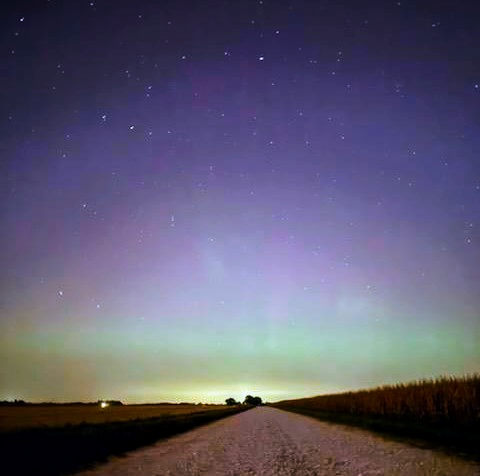Near the beginning of October, the Aurora Borealis, more commonly known as northern lights, were visible in Galesburg. As explained by Associate Professor of Physics and Astronomy Nathalie Haurberg, northern lights are created by an event known as coronal mass ejection, which occurs when charged particles or plasma from the sun shoot off, sometimes in the direction of Earth. The charged particles interact with Earth’s atmosphere, emitting specific wavelengths of light which translate to distinctive colors such as red, green, and vibrant blue.
“The reason that you see northern lights is that you have really high-energy charged particles, like electrons, that hit the atmosphere and they make a process called electronic admission. Basically, they interact with the particles in the atmosphere and excite them, and when the particles deexcite, that causes them to emit a certain wavelength of light,” Haurberg said.
Normally, northern lights are seen only near the Earth’s poles because the charged particles from the sun react to the Earth’s magnetic fields and are diverted there. However, sometimes there are too many particles to be fully diverted, and that is when northern lights can be seen in the more central parts of the continent, like Midwest America.
While northern lights are not affected by climate change or air quality, light pollution does impact humans’ ability to see them. Places that are secluded or more rural tend to have more visible northern lights. Phone cameras are also better able to distinguish the vibrancy of these lights because phone cameras have a longer exposure time to better capture the image.
“Your eye effectively refreshes at the rate that your brain refreshes. If you think of your eye as a camera, it’s like taking a picture very, very fast, at a rate of 120 hertz, whereas your phone camera can leave the exposure for a longer period of time,” Haurberg said.
Additionally, the cones of the human eye, the part that processes color, are not activated in the dark. Even if the human eye is unable to detect strong hues, phone cameras will be able to capture vibrant pictures of the northern lights.
“The rods [of your eye] are activated in the dark, but the cones are not. So until you get enough light, you don’t see color. But your phone is getting enough light all the time so it sees the color,” Haurberg said.
The frequency of these events depends on the state of the sun and how often these ejections of plasma occur. Every 11 years, our sun exhibits a state of higher activity, meaning that there is a larger likelihood for northern lights to occur, and to be seen from more centralized locations.
“Right now, we are at a period known as solar maximum, where the sun is more active, so the events that cause these coronal mass ejections have to do with what the magnetic field of the sun is doing. Basically, right now the magnetic field of the sun is really chaotic and when it’s being wild, there’s more solar storms,” Haurberg said.
Because the sun is at its peak in the cycle, this natural phenomenon could occur again. If you were unable to see the lights this time, know that more could be just around the corner.









Eleanor Lindenmayer • Nov 3, 2024 at 7:34 am
Nice job using Knox faculty to give context on a national phenomenon.